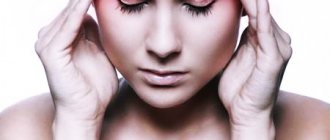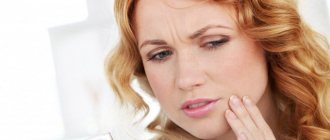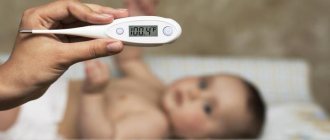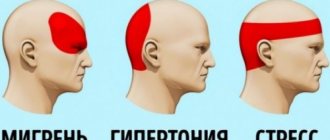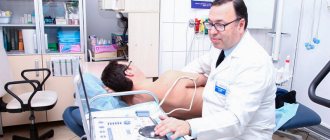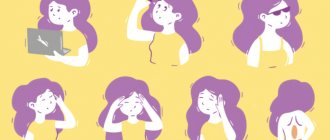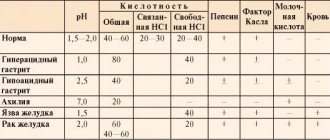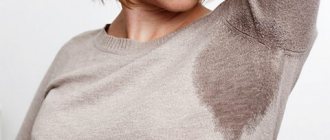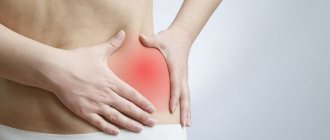Migraine
is a chronic disease that manifests itself in the form of sudden attacks of severe headache, often accompanied by nausea and, in some cases, vomiting. Photophobia and sound intolerance may also occur before and during attacks.
Migraine is a neurological disease. It is associated with disturbances in the activity of brain structures responsible for pain and other sensations. Migraine attacks can last from several hours to 3 days. The frequency of attacks also varies: from once or twice a year to 2-8 times a month, in some cases more often.
Migraine can be considered a widespread disease - one in seven adults suffers from migraine. Migraines occur three times more often in women than in men.
Manifestations of migraine are more typical for young or mature people. Usually the disease appears at the age of 18-33 years, less often - at an older age, after 50 years - extremely rarely. Cases of the disease have been reported in children over 5 years of age. After 60 years, the severity and frequency of attacks disappear, the disease, as they say, “goes away.”
Causes
Migraines are caused by vascular disorders, in which the walls of the blood vessels that supply the brain with blood expand and compress the surrounding nerve cells. It is also believed that activation of the trigeminal nerve nucleus plays a significant role in the formation of a migraine attack.
In different cases, the appearance of migraine in general can be caused by psycho-emotional overload, excessive physical activity, smoking, hormonal disorders and sudden changes in weather.
Some foods can also cause short-term vascular disorders - cheese, chocolate, red wine, etc.
Alice in Wonderland syndrome
Sometimes migraine is manifested by a violation of the blood supply to the areas of the brain responsible for the perception of visual images. Patients with such migraines have a disturbed sense of their own body diagram and sense of time. It seems to them that surrounding objects have distorted proportions. This variant of migraine was called Alice in Wonderland syndrome in honor of the character of the famous fairy tale.
Migraine symptoms
In general, a migraine is a throbbing and gradually increasing headache, often localized to only one side of the head and accompanied by nausea, vomiting and even chills.
It happens that people notice photophobia and aversion to loud sounds, as well as flickering spots before their eyes, halos around luminous objects and drowsiness.
Migraine is divided into three types with slightly different attack symptoms:
- Classic migraine is characterized by the appearance of the so-called aura, which refers to a number of signs of migraine, noticeable several minutes or days before attacks. Vision, concentration, and mental activity are impaired. And then a throbbing pain appears in one area of the head with a feeling of nausea. Within an hour, the pain reaches its peak, and paleness or redness of the skin is noted.
- Ordinary migraine - there is no neurological aura, but changes in the emotional background are observed: irritation, aggression, or, conversely, euphoria. Often this is hunger or drowsiness. Then pain appears in the frontal, temporal or occipital part of the head; the attack most often occurs at night or in the morning and lasts up to 18 hours.
- Associated migraine – combines all of the above symptoms, with the connection of more serious pathological neurological conditions. This may include paralysis of facial or visual muscles, mental disorders, etc.
Effect of hormones
Migraines are found three times more often in women than in men. Female hormones estrogens have a unique and not always predictable effect on headaches. They can both provoke an attack and prevent it. Estrogens are found in birth control pills or hormone replacement therapy medications, which are taken to reduce the symptoms of menopause.
Menstrual migraine occurs at the beginning of the menstrual cycle. The beginning of the cycle is considered the first day of menstruation. Malaise may appear two to three days before or after the onset of menstruation. Other headache attacks may occur throughout the cycle.
Menstrual migraine is different in that it is not characterized by an aura. Even in cases where a woman has already had an aura on other days of the cycle, there will most likely not be an aura during menstrual migraine.
It is generally accepted that menstrual migraine is triggered by a drop in estrogen levels, which is common in the female cycle, immediately before menstruation.
Menstrual migraine lasts longer than normal attacks, is more severe and is much more resistant to the action of specific anti-migraine drugs.
In most cases, attacks occur less frequently during menopause and stop during postmenopause.
Many women report that their migraines began during pregnancy, or that their attacks became more frequent during pregnancy. For other women, migraines appear less frequently during pregnancy or do not reach an advanced stage with severe pain. After childbirth, all changes in the frequency and severity of headaches return to their original characteristics.
How to quickly relieve pain
As soon as it becomes clear that a migraine attack will occur, it is advisable to immediately remove all irritating factors (strong odors, bright lights, etc.) from the immediate area, and, if possible, go to a quiet and dark ventilated room, taking the medicine. This could be a medication or one of the traditional medicines that will be described below.
Next, you need to tightly tie a towel around your head, apply a cold compress to your head and try to fall asleep, or remain lying with your eyes closed. This way, a migraine attack can end quickly, before it reaches its painful peak.
Chronic variant
Migraine is called chronic when its symptoms last at least 15 days every month for three months. Such migraine usually occurs against the background of some chronic disease.
Prolonged and repeated headaches are bad for people's mental health. Therefore, chronic migraine is accompanied by a variety of disorders, including anxiety, depression, and obsessions. In such cases, drug prevention of attacks is carried out with special drugs.
Massage for migraines
Since migraines are based on compression of certain areas of the brain by dilated blood vessels, you can try to relieve this physical tension through massage. It is recommended to use essential oils - especially lavender, mint and rosemary oils, which are highly effective in such cases.
Additionally, it is recommended to massage not only the head and temple area, but also the neck.
Classic massage
The simplest massage can relieve a migraine attack in a few minutes, especially in its early stages. To do this, you need to perform the following manipulations sequentially:
- fold your palms one on top of the other, place them on your forehead and perform 40 hand movements from side to side, i.e. left-right;
- Place your palms on both sides of your head so that your thumbs are next to your ears. Make 40 movements with your hands up and down;
- place your palms on the back of your head so that they touch with your little fingers and massage the back of your head with the ribs of your hands from bottom to top;
- press your temples with your thumbs, closing your eyes, for 1 minute;
- squeeze your head with your palms on both sides and maintain this position for 30 seconds;
- press with both thumbs at once on the space between the eyebrows for 15-20 seconds.
Acupressure
With the correct influence on certain points, a migraine attack can end very quickly - it is recommended to insert your thumbs into your ears and press on the tragus from the inside forward, and then slightly upward, towards the eyes.
Press, release and repeat this 3 times with an interval of 1-2 minutes. It is believed that this massage can relieve not only migraines, but also headaches of any origin.
Acupuncture massage for migraines
As a result of a number of studies, it was found that acupuncture pressure on certain neurons can cure migraine. Acupuncture stimulates or irritates the nerve endings that are responsible for pain and important substances in the blood, the lack of which can lead to an attack.
Acupuncture massage can both relieve attacks and affect the cause of migraines in the period between them. But only a trusted specialist should do it, otherwise the procedure may worsen the condition.
Diagnosis of the disease
A course of therapy for migraines is prescribed only after a comprehensive study. A number of diagnostic measures make it possible to make an accurate diagnosis, find out the cause of the disease and carry out the correct treatment. Incorrect therapy or its absence leads to various complications.
Helpful information
First of all, the neurologist interviews the patient to determine the duration of the attack, frequency of occurrence, and the presence of accompanying symptoms.
The main diagnostic method is magnetic resonance imaging of the cervical spine. The procedure allows you to determine circulatory disorders in the brain.
Rheoencephalography is also prescribed. The technique is aimed at establishing brain activity using high-frequency electric current. The procedure is carried out using special sensors that are fixed on the patient’s head.
The neurologist also carries out differential diagnosis, since it is important to distinguish migraine from simple headache.
The disease is characterized by intense symptoms. The pain is pulsating and localized only on one side. A simple headache is pressing and is bilateral in nature. It does not increase with bending or physical activity.
Only a doctor can tell you how to treat migraine after studying the results of diagnostic measures and interviewing the patient.
Therapeutic baths
Since migraine is largely associated with nervous tension, a relaxing procedure such as a bath can help eliminate it. It can both reduce the clinical manifestations of migraine and speed up its end.
Noticeable effectiveness is shown by adding mustard to baths in any of its forms using the following methods:
- with mustard powder - dilute a handful of powder in water to a paste and dilute it in a bathtub filled with comfortable water. Take a bath for 10 minutes.
- with mustard seeds - pour 2 large spoons of raw material with 2 mugs of water, add 1 large spoon of dry sage herb and leave for half an hour. Then add to the bath.
- with mustard oil - add 10 drops to a mug of warm water and shake the mixture in some other closed container. Then add the composition to a warm bath.
Important! If mustard is too irritating to the skin of the body or causes allergies, you can use an infusion of lemon balm or chamomile, citrus oils, or even regular (or flavored sea salt) as a replacement option. These components will also help.
Basilar variant
Migraine is accompanied by narrowing of blood vessels and disruption of blood supply to certain areas of the brain. When the blood supply to the brain is disrupted in the basin of the basilar artery and its branches, basilar migraine develops. It is characterized by a peculiar aura associated with damage to the occipital lobe of the brain, brain stem and cerebellum. The following symptoms appear:
- speech disorder;
- dizziness;
- noise in ears;
- double vision;
- impaired balance and coordination of movements;
- confusion.
The listed symptoms are accompanied by the patient’s agitation, motor restlessness and greatly complicate diagnosis.
Compresses
For migraines, compresses with contrasting properties are indicated, as they have a necessary effect on the blood vessels. You can simply soak towels in hot and cold water and place one on your forehead and the other under the back of your head and switch places every two minutes. This needs to be done 6 times in a row, after which the migraine attack should noticeably subside.
In addition, you can apply slices of raw potatoes, raw cabbage leaves or aloe leaves cut lengthwise to your forehead and temples, securing them with a plaster and a bandage on top. And another folk recipe for a compress for migraines is fabric soaked in oregano infusion.
Dehydration
Lack of water affects the human body at all levels and can lead to dizziness, nausea and migraines. 1/3 of migraine sufferers say that they should never become dehydrated during such conditions.
What to do: always carry a bottle of water with you and monitor your fluid intake (30 ml per 1 kg of weight), limit your intake of diuretics (if you are taking them). Sometimes an oncoming migraine can be stopped even by drinking a glass of water.
Herbal decoctions and infusions
Traditional medicine is inseparable from the use of various herbal infusions and decoctions. Oregano helps well against migraines - it can be used not only for compresses, but also as a decoction for oral administration. If migraine attacks occur frequently, you should drink it every day, three times a day (according to the instructions on the package) until the condition improves.
with raspberry leaves and stems can prevent an attack in case of signs that foreshadow it .
Soothing teas made from chamomile, motherwort, hawthorn, and valerian - individually or as part of a collection.
Another option is an alcohol infusion of walnut partitions . It must be taken 1 large spoon before meals for 25 days for the infusion to be effective.
Contraindications for migraine
To prevent migraine treatment from being in vain, it is important to know what is prohibited in the case of this problem. The main contraindications here include drinking alcohol and smoking, as well as consuming dark chocolate and cheese, because all of this is nothing more than provoking factors.
Lack of sleep and overwork are also prohibited.
Other effective treatments
One of the most effective folk methods is considered to be a decoction of garlic in milk - to prepare it you need to chop 10 cloves of garlic, pour 50 ml of milk over them, heat to a boil, hold on fire for a couple of minutes, then cool and strain. The finished product must be instilled into each ear, a few drops, held there for a minute and poured out.
Another recipe with milk includes a chicken egg. It needs to be broken into a mug and pour boiling milk over it, stirring gently and immediately drink in small sips. Within a week, this remedy should be consumed one serving at a time, and the disease will recede.
You can also inhale vinegar vapors. To do this, mix a mug of water and natural apple cider vinegar, put the mixture on the fire and wait for steam to appear. And then you need to tilt your head over the container with the prepared composition and inhale.
Diagnosis
In a situation with recurring headaches, it is imperative to visit a doctor. Diagnosis is made on the basis of clinical indicators based on a survey of the patient and his general examination. It is important to consider that paroxysms of a condition relevant to migraine (that is, systematically recurring attacks) can act as the first symptom indicating a brain tumor or vascular malformation (in particular, this implies the possible relevance for the patient of developmental abnormalities, as a result of which pronounced changes in the functions of blood vessels and their structure).
Given the possible seriousness of the patient’s condition, a detailed examination is required to exclude an organic process. In particular, you will need to visit an ophthalmologist to check the fundus, visual acuity and visual field. You will also need electroencephalography, CT and MRI procedures.
Effective medicines
Treating migraines at home can only involve taking medications. It is important to take into account that the usual painkillers are ibuprofen, no-spa, etc. etc., are useless in case of migraine.
The most effective medications are those from the triptan group - Sumatriptan, Frovatriptan, Zomig, etc. And for mild migraines, analgesics such as Tempalgin and Citramon can help, but it is important to take them at the very beginning of the attack. In extreme cases, take Midrin or Dihydroergotamine.
Is prevention possible?
According to expert opinions, compliance with preventive measures significantly reduces the number of migraine attacks. The following may be effective:
- Limiting contact or completely eliminating exposure to provoking factors;
- Avoid prolonged exposure to TV or computer;
- Minimize the duration of telephone conversations;
- Compliance with the principles of healthy eating, physical activity and sleep;
- Keeping an individual diary, which notes the frequency of attacks, their duration, provoking factors and effective assistance measures. This will allow us to draw conclusions about the prognosis of the disease and the prospects for treatment;
- Taking medications containing magnesium and B vitamins;
- Taking drugs from one of the groups of drugs: adrenergic blockers (propranolol), anticonvulsants (topiramate), antidepressants (venlafaxine).
Interesting! Today, injectable drugs, nasal sprays and physiotherapeutic techniques have been developed that quickly stop even the most severe migraine attacks. But the greatest importance in the fight against this problem belongs to the organization of medical care, teaching patients the rules for stopping and preventing attacks, and the usefulness of interaction between specialists and patients!
